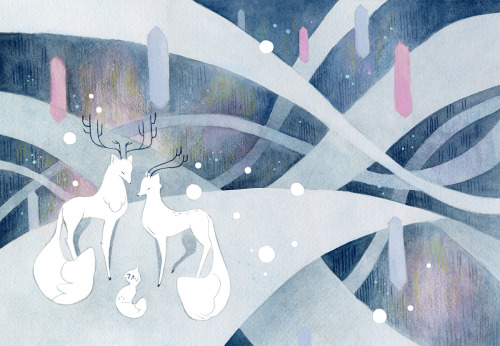Some of you may have seen the color rough of this in my instagram stories, but I finally got around
Some of you may have seen the color rough of this in my instagram stories, but I finally got around to scanning the paintings I created over my winter break. Here’s the first one – a little bit of Hilda fan art. I love that show so much! The second I saw this scene, I knew I had to paint it.This painting also served as technique experiment. If you’d like to read the nitty gritty technical details, click below~Okay, so.I paint in winsor newton gouache watered down like watercolor. I do this because gouache doesn’t bleed like watercolor does, meaning it’s easier to get crisp, solid shapes. Ever had trouble getting watercolor to not look blotchy? I recommend trying watered-down gouache! The major draw back of gouache is that there are fewer colors available (especially that are lightfast, non-toxic, and permanent) and sometimes you want colors to blend and the paint just isn’t going to do that for you. But painting thinly in gouache has one other large draw back: unlike opaque gouache, I can’t paint light colors on top of dark. With watercolor-like paints, you must move from light to dark and can’t make corrections. I’ve developed a few tricks over the years to get around this (super clean wet paper towels work like watercolor erasers for one!), but mostly I’ve just gotten really good at painting it right the first time…as time consuming as that is. If you’re curious to see some process shots, I upload them for most of my pieces to my instagram stories, and some are highlighted. But anyway, most of my paintings take around 4-6 hours just to paint, not including all the lead up time of sketching, color-roughing, and transferring. The more complex ones, 12 hours or more. Lately, however, I’ve learned a cool new technique! In the past, I’ve tried painting light colors more opaquely in winsor newton gouache on top of my thinner winsor newton dark washes without much success (it just soaks in) – but it turns out you CAN paint holbein acryla gouache on top of winsor newton without it simply disappearing! The little hexagon-ish shapes up there were painted in holbein after the rest of the piece was completed (the white circles are white gel pen). For best results, I recommend not mixing the holbein acryla gouache with any other gouaches, including winsor newton. I used completely different palettes and brushes for them (it’s a sticky paint and hard to clean!). Instead of using these paints like more colors to add into my usual ones, I instead use them like correction fluid and in moderation. Just like with winsor newton, I recommend checking the lightfastness and permanency of each color, but more of holbein’s range is lightfast (likely because it’s plastic).With this technique, I’ve been able to not only paint small details in lighter colors after a series of dark washes but have been able to mix matching colors in holbein to make corrections to my winsor newton, too. The best method for making the two paints blend into each other (so it doesn’t look like thick paint is sitting on top of the thinner paint underneath) is to not paint the holbein TOO thickly; instead, paint just opaquely enough to cover what’s below.Another example of this technique is my new year’s piece, which I actually painted after this one – the little confettis were painted with holbein, as well as the ribbons. It meant I didn’t have to be TOO perfect with my background washes because I could go back in and correct in a way that wasn’t noticeable…and it meant I didn’t have to try to paint AROUND all those little confettis, I mean talk about a nightmare. And let me tell you, not having to paint around every tiny detail saves a ton of time! I time myself for every painting in hour-long pomodoros, and paintings that would have once taken 12 hours now take around 4. That new year’s piece would have once taken me two work days, but took only one. GAME CHANGER.So I just had to share, in case anyone wanted to try the technique. I know lots of artists paint opaque gouache on top of watercolor washes, and this is kind of a similar idea to that…but I wanted to avoid the two paints looking different, and wanted it to look like I had painted the entire piece with one technique. Painting in washes is still a perfectionist’s technique and you still have to get almost everything right on the first pass, but so long as you don’t overdo the areas painted in holbein acryla gouache on top, this method will let you paint tiny corrections and tiny details!Hope someone found this useful! -- source link
Tumblr Blog : vanessagillings.tumblr.com
#childrens illustration#childrens illustrator#gouache#gouache painting

